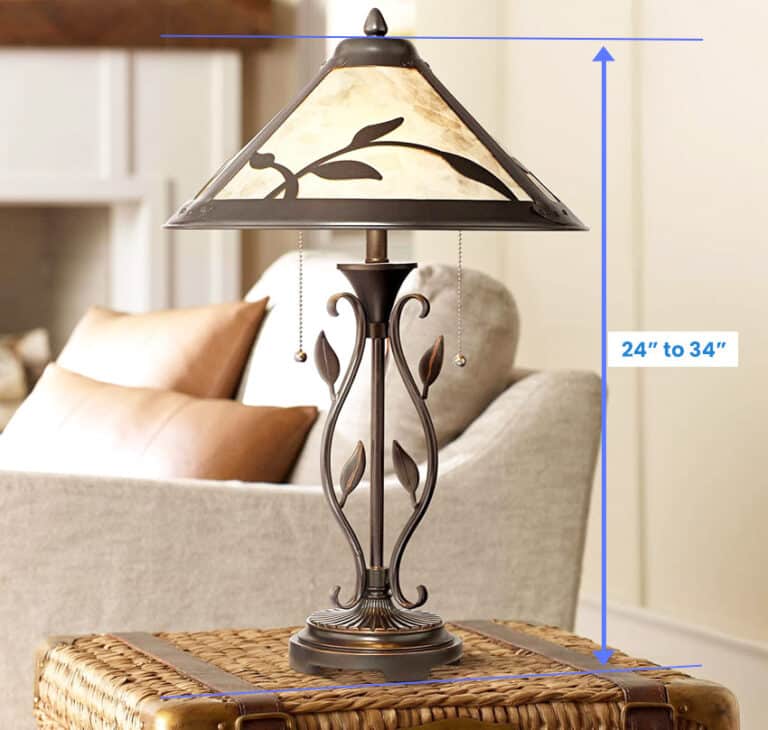High Bay Light Fixtures (Types & Buying Guide)

One thing that you need to know about high bay light fixtures is that they’re the definite go-to lighting fixture of choice whenever a large indoor space requires some sort of illumination. Other types of lighting will typically not provide the brightness necessary to fully and adequately illuminate the floor space of a large area.
Quicklook: Different High Bay Light Fixture Types
• LED Bay Lights
• Induction Lights
• Metal Halide Lights
• Fluorescent Lights
Where Are High Bay Light Fixtures Used?

Think about large and cavernous spaces such as warehouses, manufacturing plants and facilities, gymnasiums, and other buildings that color a lot of both horizontal and vertical space. Big spaces such as this would typically require very powerful lighting options in order for them to be appropriate or ample.
High bay lighting fixtures are the type that hangs from the ceiling or are suspended from the ceiling with the use of pendants, chains, or even hooks. There are also some instances wherein they might be directly affixed to the ceilings without these additional supports.
High bay ceilings aren’t all that common in the residential scene, but they are practically ubiquitous in the commercial scene. They can be found all over different public buildings and establishments such as the following:
• University and school gyms
• Department stores and other big retail businesses
• Recreation centers, community centers, and other similar municipal facilities
• Industrial facilities that particularly require LED lighting as an operational requirement
• Warehouses and other vertically tall buildings
• Airport hangars
What Are High Ceiling Lighting Fixtures?
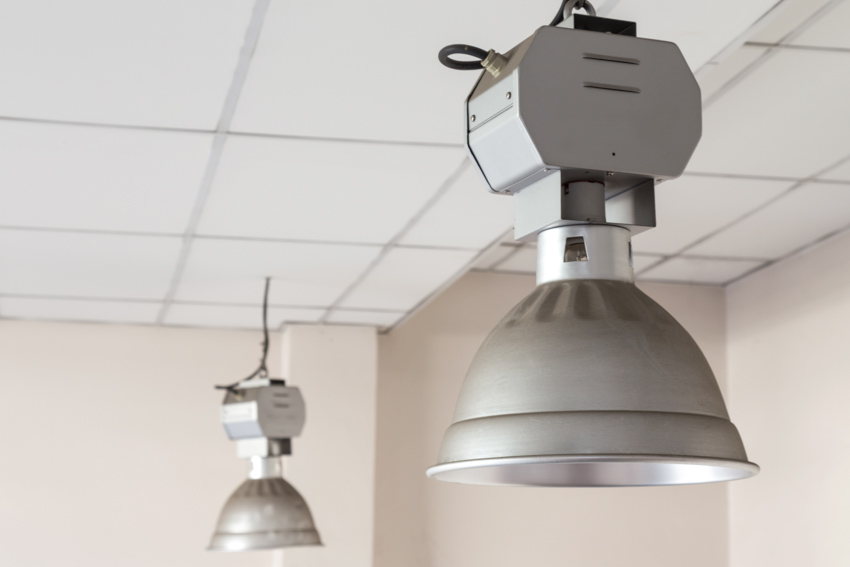
This leads us to the question of, apart from the fact that it’s installed pretty high up on the ceiling and it’s predominantly made out of LED lighting, what else is there to know about bay lighting?
By definition, bay lighting basically refers to the type used in spaces with ceilings that measure about 20 to 40 feet higher than the floor or, at times even much taller than that. This is a pretty tall requirement, so to speak.
There are two types of bay lighting: low and high. The main differentiator would be the leveling of the fixtures from the floor up.
The main requirement of bay lights, aside from the height, is that they would need to provide adequate lighting while at the same time minimizing glares from such high lumens delivered.
Low bay lighting may be below 100 watts, whereas high bay units typically go at a range of 100 watts or, at times even much higher than that. They also have different hanging methods. Low bay lights are mounted through chains and hooks.
High bay fixtures hang from certain ceiling design types with chains, hooks, pendants, and other suspension methods. It isn’t uncommon to see them hung from the ceiling similar to how troffer lights are suspended.
High bay lights need special reflectors. These reflectors are typically made out of prismatic components or aluminum to allow illumination to flow down to the floor or to get the light diffused.
This is for the purpose of illuminating elevated objects such as shelves and the like.
There are a lot of varieties in high bay lighting. There are some that are induction types, LED types, metal halide types, fluorescent, and so on and so forth.
The shapes can also vary from linear, to round, to grid mount, to geometric or architectural, etc. These types of light fixtures have a wide range of applications, as mentioned above.
Knowing what the different types of bay lighting are out there would help you better decide what would be suitable for you.
Here are some of the most important variables to know about when it comes to considering which particular type of high bay lights to go for.
LED Bay Lighting

These high bay types of ceiling lights are the most popular in the market right now. There have been over 10 billion units sold back in 2019 and higher back in 2020 and the past year.
They have become so popular that it would probably be safe to say that they have officially overtaken the sales of fluorescent lamps in the market.
The Light Emitting Diode (LED) bulbs are revolutionizing the whole lighting industry. Gone are the days of mediocre lighting of the incandescent bulb and the compact fluorescent light (CFL). – LED Lighting for Your Home & Business, Simon Marlow
This growth in LED lights’ popularity isn’t purely based on luck. LED lighting has a wide range of benefits that turn out to be too significant to ignore. It uses 75% less energy, so utility costs are drastically lowered. They last 25 times longer compared to other types of lights.
These high-bay fixtures are also known to be far easier to install compared to fluorescent lamps. On top of all of these things, there are special rebates that you can take advantage of depending on your area as local government units usually incentivize lower energy and disposal costs.
LED Shop Lights

If you’re outfitting a workshop or some type of garage, you need to make sure that you have ample lighting all around. Although you can get illumination from lamps or other similar fixtures, this can be quite limiting.
This is where LED shop lights come into play. The reason why they’re so great is that they have a lot of different features to bring to the table that regular lighting fixtures just can’t even come close to.
Brightness: LED shop lights are known to bring in way more lumens compared to other types. They can range anywhere from 5,000 to 12,000 lumens or more.
Check the brightness levels accordingly depending on the amount of space you actually need illumination for.
Color temperature: Aside from the brightness, you also need to pay attention to the color temperature. This will more or less give you a bit of an idea about the kind of color that the bulb produces.
There will usually be options such as 6,000K or 6,500K. These are more on the bluish side. Other options in the 4,000K range are more on the yellowish side.
Wattage: You also need to keep in mind the wattage rating when you happen to be in the market for LED lights. They will tell you a lot about the power consumption. On top of all of this, you will also get an idea about the kind of output it will give out in terms of its brightness.
A 100-watt LED light will definitely end up using far more power compared to a 50-watt one. Although that may be the case, it will definitely turn out to be brighter so it may be well worth the energy costs at the end of the day. Think about your wattage requirement so that you’ll be able to decide accordingly.
Induction Lights

Induction lights have been around for about 100 years, but technological advances have been made in the generation and electronic ballasts used. Induction lighting has been made more affordable than ever.
They come as great alternatives specifically for municipal and commercial uses, which is why they work great as high bay fixtures. They are energy efficient and have been known to be the top choice for movements that would like to “go green”.
Surprisingly, it is similar to a fluorescent lamp in that it has mercury in its gas fill inside its bulb. This gas fill becomes excited when electricity is applied to it. This makes it emit UV rays that are then converted into white light that’s brought on by the bulb’s phosphor coating.
It differs from fluorescent lamps because fluorescent lamps use electrodes to strike an internal arc. These electrodes degrade over time, causing the fluorescent lamp to degrade over time as well, whereas induction lamps only need the gas fill. This means that they last much longer, at times by up to 60,000 hours or so.
Metal Halide Lights

Metal halide lights have been around since the 60s. They are considered viable lighting sources for a wide range of applications, the most popular of which is being used as high bay fixtures.
Metal halide has the ability to vividly emit white light. It is known to have a long life span. It is also known to have thrice the luminous efficacy compared to traditional incandescent lamps in the market. It is a type of HID or high-intensity discharge lamp.
MH lamps work because they have an internal electrical arc that goes through a gaseous mix, and this, in turn, creates light. The mixture of gases is usually comprised of xenon, mercury, argon, and a variety of metal halides.
This is where its name has been derived from. Metal halides are manufactured by combining a metal with halogen. These metals have normally been premixed with either bromine or iodine. The color temperature of the light emitted is usually determined by the type of metal halide that’s being used.
Fluorescent Lights

Fluorescent lighting is pretty common nowadays and there’s probably a pretty good percentage that you already have a good idea about what it is and how it works. There’s a lot more fluorescent lighting than meets the eye, though.
Although you know a little bit about how it is known to wash out your complexion or even hurt the eyes a little, it has a lot of other variables to it that might affect your decision when you happen to be in the market for what type of high bay fixture to go for.
It’s a very versatile type of lighting, and it can be commonly seen in groceries, offices, schools, and even homes.
It is also known to be way more energy efficient compared to halogen and incandescent light bulbs. They also tend to cost less upfront compared to LED lights.
Fluorescent lights come in different types: fluorescent bent, linear fluorescent, and CFLs or compact fluorescent lamps. High bay lights typically make use of linear fluorescent tubes as they’re easy to install as overhead fixtures and can be commonly found in commercial buildings.
Fluorescent lamps are dependent on the chemical reaction inside of the glass tube for the creation of light. This usually involves having mercury vapor evaporate as well as other gases inside it.
There’s usually an invisible UV light that reacts with the phosphor powder coating inside of a glass tube. The type that comes out of it is described as “fluorescent” in nature, which is how this particular type of lighting got its name.
How Do I Choose Light Wattage?

When deciding on the wattage of the high bay lighting fixtures that you are planning on purchasing, you have to be dependent on the ceiling height of the actual structure that you’re getting the lights installed in. This is where the concept of lumens will come in.
Lumens is basically the measurement of visible light produced by a particular source. Technically speaking, all lighting sources are measured in lumens. You need to base the height of your structure’s ceiling on the lumens requirement you need when you’re deciding on your high bay light wattage.
Here’s a quick reference guide to help you out.
Over 40 feet ceiling height – 40,000 lumens and above
30 to 40 feet ceiling height – 30,000 to 39,000 lumens
20 to 30 feet ceiling height – 20,000 to 29,000 lumens
15 to 20 feet ceiling height – 15,000 to 19,000 lumens
There are also additional factors that you need to think about, such as what type of application or use you will have for the space. Typically, manufacturing and retail will end up requiring brighter illumination, whereas recreation and warehouse applications or even storage will require far less.
The size of the entire space will also need to be considered when you’re thinking about your lighting choices.
The Importance of Beams for Lighting Mounting Height
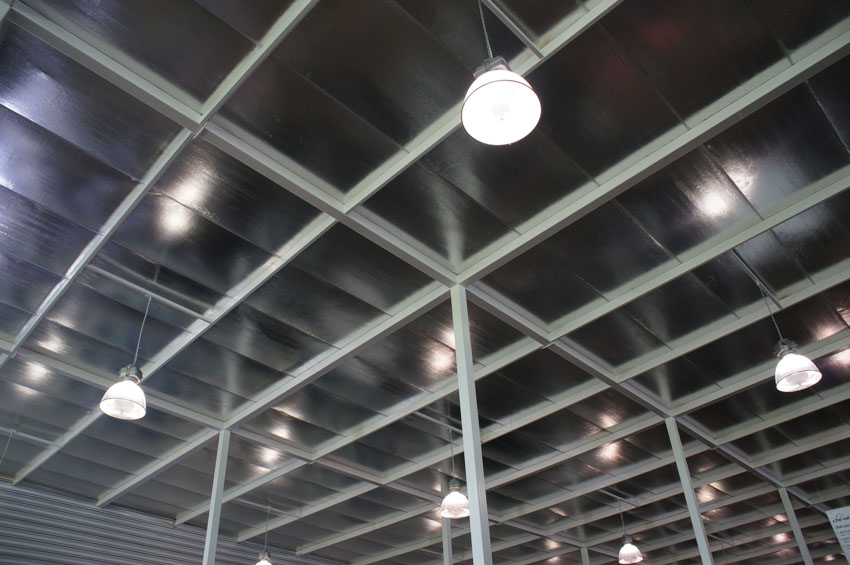
For the high bay lights to operate efficiently from high heights, such as 20 to 40 feet and above, reflectors are an absolute requirement. These aren’t just average reflectors that you can buy from a store somewhere.
These reflectors must be specially engineered and come in special lens angles. This ensures that the illumination actually evenly gets to the floor and that it isn’t wasted.
The beam angles also play a very important role in high bay lighting. The common beam angles that are being used for these types of lights are at 60, 90, and 120 degrees.
Narrow beams help out with the creation of more focused light beams and this can provide high levels of lamination on the floor.
On the other hand, wider beam angles allow large open areas to get an even distribution of lighting, especially if they have slightly lower roof heights. The general rule of thumb is that the wider the beam angles, the lower it is for the ceiling height.
Minimum Height for High Ceiling Lights
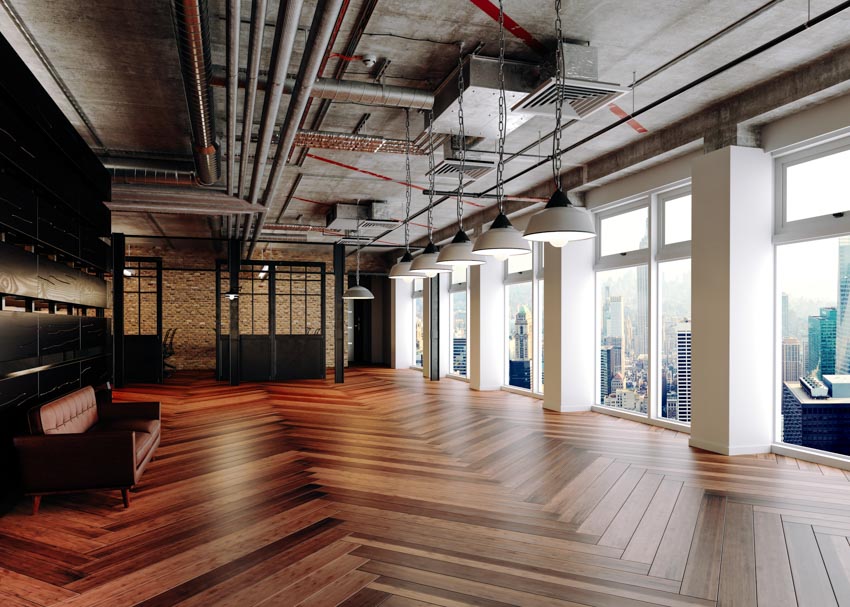
Although it’s been published that high bay lights require a range of 20 to 40 feet from the floor. There are instances wherein it can be acceptable to have them at 15 feet above the floor.
Anything lower than 15 feet would now require low bay lights. You won’t be maximizing the benefits if your ceiling height is lower than that 15 feet.
Bay Light Shapes

There isn’t a lot to go with by way of variety when it comes to high bay fixture shapes. This may be because high bay lights are for utility or function in nature instead of for aesthetics.
There are usually 3 main shapes to choose from when you are in the high bay lighting market. They are as follows:
Round High Bay Lights: These are commonly known as UFO high bays. This is because of their shape, which is saucer-like and round. Round-high bay lights only have one contact point with the ceiling.
This makes them really easy to install and they normally provide a circular type of beam angle positioned at 120 degrees or so. This is a fairly large beam spread so it covers a wide area while at the same time, still provides powerful illumination.
This is a great choice to illuminate wide-open areas such as warehouses, factories, sports arenas, aircraft hangars, wholesale stores, and groceries.
Square High Bay Lights: Square high bay lights are very similar to the concept of UFO or round high bay lights. The only difference is the actual shape of the lamps that are being installed.
But unlike the UFO lights, they have more options when it comes to installation. They can either be suspended directly from the ceiling with one contact point or hung out with chains and cables or like troffer lights.
Linear High Bay LED Lights: Linear high bay LED lights can be commonly seen in wholesale, retail stores, grocery stores, and other spaces with a lot of shelving and aisles.
The kind of illumination these fixtures provide is ideal for fitness centers, event halls, conference halls, etc. It offers rectangular illumination and can be mounted either directly to the ceiling or through chains and cables, depending on what your needs will turn out to be.
Bay Lights in the Garage
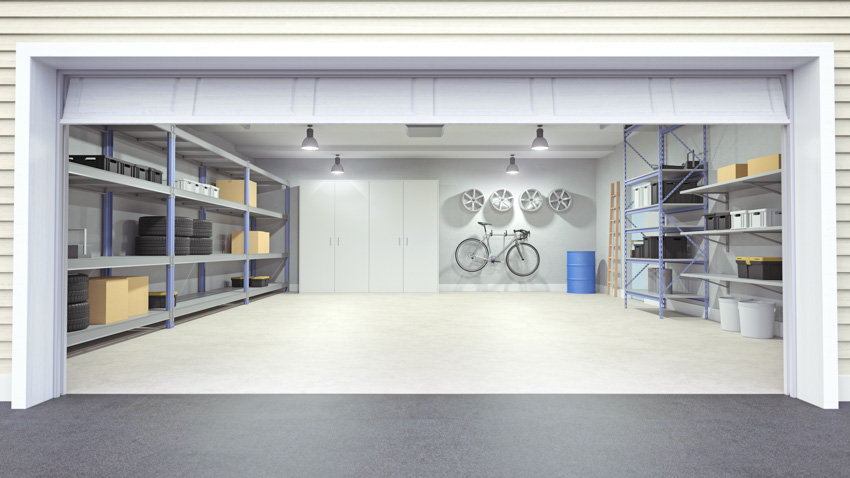
Here’s the thing, high bay light fixtures are designed to be in spaces or rooms that have ceiling heights of 20 feet or taller. Most of them come with tighter beam angles as well as reflectors.
This helps with focusing the light more on the fact that it needs to bridge a longer distance all the way from the ceiling to the floor. Those same strengths, though would make these types of garage lighting poor choices for residences.
Here are a few reasons why you should opt not to use high bay lights in your garage.
First reason: They cast shadows that you don’t necessarily want in that space.
This is the biggest reason why you should completely opt out of using high bay lights in your garage. You have to remember that these fixtures were originally designed to be set up in warehouses.
A warehouse needs powerful lighting that’s focused on illuminating the floor. There isn’t any regard, even if shadows are cast on the ceiling, because that’s not where the products or the people are.
The beam angle of the light being cast is critical because it can either focus into a narrow beam, similar to a spotlight, or it can spread out into a wide angle (for low bay lights) and spread out, providing even coverage over large floor space.
Second reason: High bay fixtures will end up using more energy or power.
The start and end to this point is that high bay lights consume more energy compared to low bay. We’re not talking about power efficiency here, but raw power consumption.
Power efficiency is a rating and it can be a fair and constant variable in a manufacturer’s lineup whereas raw power consumption is really more of from a utility cost standpoint.
High bay lights use more electricity because they have been designed to provide more illumination or output over a greater distance. They output more lumens in light overall, which is great.
However, the downside is that those beams of light are concentrated in one place because of how narrow the beam angles are. The goal of putting in lights for a residential garage is to get lighting that’s evenly spread out in the garage instead of just intense beams in one area.
Third reason: High bay light fixtures cost more: both upfront and in the long run.
There isn’t any way around it. Cost really is a challenge, especially on the residential application front. Some things might end up costing more upfront but this results in savings further down the road.
This is not the case with high bay lights. The cost is already initially high the first time you purchase them and get them installed and they will continue to cost you a lot of money because of how much power they consume. This is considered a bit of a lose-lose situation if you’re a homeowner.
How Many LED Lights Do I Need?

What counts as enough light? This is a difficult question to answer on its own without having to get to the point to actually calculate how many LED high bay fixtures you will actually need in order for you to create a space that’s well-lit.
Obviously, the main prerequisite here is that the application needs to either be for commercial purposes or that the ceiling height is 20 feet or above.
When you’ve ticked all those boxes out, here’s how you will be able to determine just how many LED lights you will actually need for a space at any given time.
You first need to familiarize yourself with certain terms:
Lumens: We’ve discussed this in passing above. But by definition, lumens is how light is measured based on how much brightness it actually emits.
Watts: Watts measures how much energy or electricity is consumed to reach or attain a certain brightness level. Hence, you need to check out the lumens-per-watt ratio.
Wattage equivalence: Since we’ve now previously defined watts and lumens, it’s easier to discuss the concept of lighting in terms of wattage equivalence.
If a 10-watt LED light produces 1,500 lumens, for example, is compared to a 100-watt incandescent bulb that produces the same lumens; the LED can be advertised as a “100-watt equivalent”.
Efficacy: This relates to the number of lumens that an LED light can produce for every single watt that it ends up consuming. The higher the number, the more efficient the LED lamp is supposed to be.
So how much light is enough? Determine the square footage of your space first.
Make it a point to measure out the length of the space and multiply it by the width. This will yield the square footage measurement. For example, if a room is 10 feet wide and 10 feet long, it will yield a square footage of 100 square feet.
You must also determine the room type and purpose to get the foot-candle requirement.
A foot candle is how bright a certain light source is one foot away. Lighting requirements vary greatly depending on what type of room you’re actually illuminating. For example, a kitchen or bathroom might have a higher foot candle requirement compared to a bedroom.
Determine your lumens requirement. In order to get this, you will need to multiply your foot candle requirement by your actual square footage.
For example, you need to illuminate a 100 square foot garage. Let’s say, you checked it out at 10 to 20 foot candles (this is variable and completely up to your requirements or preferences).
This means that you will need any range from 1,000 to 2,000 lumens for that said garage. Let’s say you wanted more and checked it out at 30 to 40-foot candles. This means that you will need around 3,000 to 4,000 lumens.
These are just sample calculations but the rule of thumb is for you to consider your ceiling height as well. The higher the ceiling, the higher your foot candle requirements should be.
Keep that in mind when you’re trying to calculate how much light you will need. These measurements are particularly important for high bay lights as you would need to have sufficient illumination all across the board.
See more related content in our article about the pros and cons of LED lights on this page.



